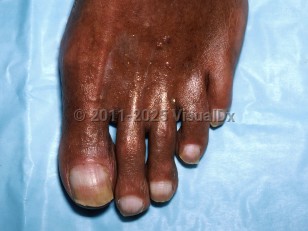Half and half nail syndrome - Nail and Distal Digit
Alerts and Notices
Important News & Links
Synopsis

Half-and-half nails are seen in an estimated 20%-50% of chronic renal failure patients. It is also seen in up to 84% of patients with azotemia and 8%-13% of hemodialysis patients; there is some debate whether the frequency of these changes correlates with duration of dialysis. Other reported causes include Kawasaki disease, hepatic cirrhosis, pellagra, zinc deficiency, chemotherapy, Behçet disease, and Crohn disease. Half-and-half nails have also been reported in patients without any systemic abnormality.
Fingernails are affected more often than toenails. Clinically, nails have a proximal pale pink or dull white "ground glass appearance" that is sharply demarcated from a red, pink, or brown distal portion. The transverse distal bands occupy 20%-60% of the total nail length.
There is no correlation between the distal band length and severity of renal failure. Furthermore, the half-and-half nail pattern is persistent, as there is no tendency of the bands to move with nail growth. Nonetheless, this phenomenon may reverse itself after successful renal transplantation, but not with hemodialysis or changes in hemoglobin or albumin levels.
Codes
L60.8 – Other nail disorders
SNOMEDCT:
50077007 – Half-and-half nail
Look For
Subscription Required
Diagnostic Pearls
Subscription Required
Differential Diagnosis & Pitfalls

Subscription Required
Best Tests
Subscription Required
Management Pearls
Subscription Required
Therapy
Subscription Required
Drug Reaction Data
Subscription Required
References
Subscription Required
Last Updated:01/27/2025

